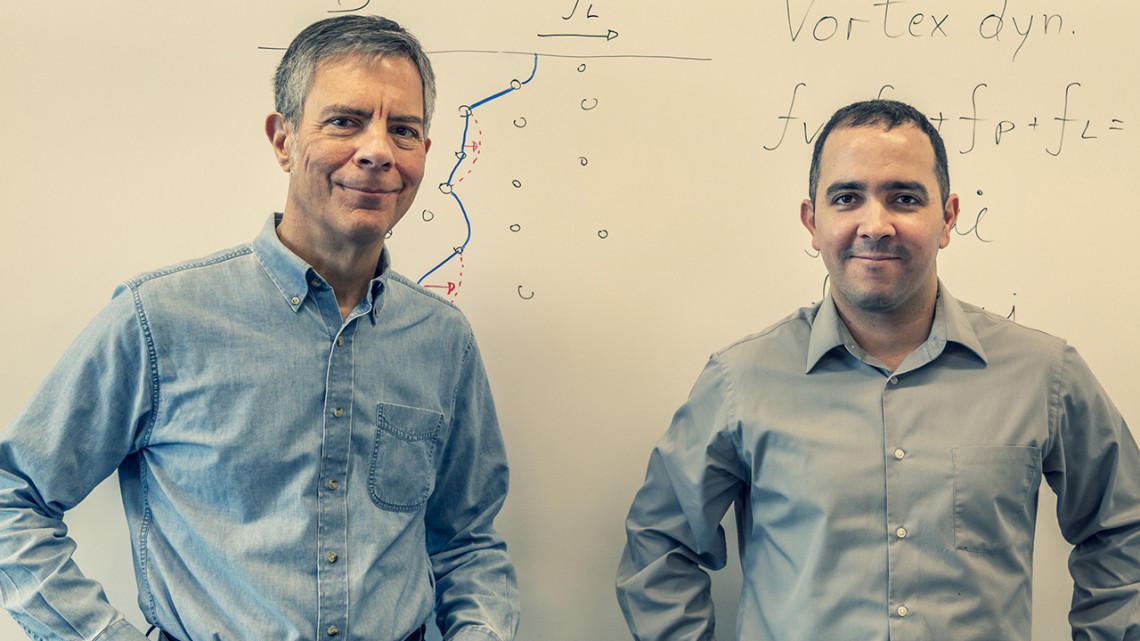
Professor James Sethna, left, and postdoctoral theorist Danilo Liarte, both members of the Center for Bright Beams, are working toward more efficient particle accelerators.
Next-gen particle accelerator is aim of Bright Beams work
By Rick Ryan
Particle accelerators have been used for decades to answer questions regarding the nuclei of atoms, the smallest forms of matter. New research is helping address current challenges and develop more efficient accelerators.
Currently, particles get accelerated thanks to metallic chambers known as superconducting radio-frequency cavities. These chambers, also known as RF cavities, are spaced along a particle accelerator. As a beam of particles passes through a cavity, it is hit with energy from radio waves, causing it to accelerate. However, in order for the RF cavity to be superconducting, it must be cooled with liquid helium to near zero kelvins – approximately minus 460 degrees Fahrenheit – an expensive proposition.
Another problem is dissipation of energy, in the form of heat, from the radio waves. Experimentalists traditionally have been able to bypass some of the negative impacts by carefully reducing the temperature of the RF cavity to well below the superconducting threshold. While this approach works, researchers are seeking a more efficient and lasting solution.
Recently, theorists and experimentalists from the Center for Bright Beams (CBB) – a multi-institution National Science Foundation Science and Technology Center led by Cornell – published research that may help enhance the theoretical framework used to model future accelerators. The ultimate goal is to simplify the refrigeration needs for RF cavities while reducing RF power losses.
Postdoctoral theorist Danilo Liarte is lead author of “Vortex Dynamics and Losses Due to Pinning: Dissipation from Trapped Magnetic Flux in Resonant Superconducting Radio-Frequency Cavities,” published Nov. 27 in Physical Review Applied. Senior authors are Cornell physics professors James Sethna and Matthias Liepe, both CBB members.
The material of choice for today’s accelerating cavities is niobium, which becomes superconducting at a higher temperature than any other pure metal. “Higher” is relative, though: The operating temperature is minus 456 degrees Fahrenheit, or 2 kelvins, and requires costly cryogenic equipment to cool the cavity in a bath of liquid helium.
“A current challenge in accelerator physics is to maximize the accelerating field, and minimize the dissipation (heat) within the superconducting cavity,” said Liarte, a member of the Sethna lab. “By understanding the power losses from having these theoretical models, we can better understand the material properties of the cavities.”
Future accelerators, Liarte said, are likely to be compound superconductors such as triniobium-tin (Nb3Sn). These compounds have better intrinsic properties than niobium and could operate at a higher superconducting temperature – minus 452 degrees Fahrenheit, or 4.2 kelvins.
While this jump in temperature may seem negligible, it can drastically reduce the costs of operating SRF cavities by eliminating the need for superfluid helium refrigeration.
While understanding of Nb3Sn cavities is still limited, there are certain properties that can be better understood by looking at multiple types of superconductors.
For their most recent study, the group collected data from three separate cavity treatments: niobium sprayed onto copper, Nb3Sn and niobium with impurities.
Each of these materials provided insight into one of the most sought-after pieces of evidence for the negative impacts on accelerating cavities: vortex lines. Considered the “smoking gun” of superconducting cavities, these lines of errant magnetic fields within the cavity are surrounded by vortices of electrons that interfere with the desired radio waves.
“Pretty much all of the superconducting materials that we use will have at least some vortex lines in them,” said contributor Peter Koufalis, a doctoral student in the Liepe group and a member of the Cornell Laboratory for Accelerator-based Sciences and Education (CLASSE). “It is very hard to completely get rid of them.”
These vortices can get trapped within the active layer of the superconductor, creating magnetic fields that cause disarray within what should be a finely ordered system of acceleration. The vortex lines get trapped in the inevitable impurities of the cavity, the group found, and can dissipate RF power more quickly than earlier theorized.
“What we have now is basically a model that explains this behavior in a quantitative and qualitative manner,” Liarte said.
Other contributors to the study included Daniel Hall, Ph.D. ’17, from the Liepe group; doctoral student Alen Senanian from the Sethna group; and Akira Miyazaki of the European Organization for Nuclear Research (CERN) and the University of Manchester, England.
This work, conducted at Cornell and CERN, was supported by the National Science Foundation and the U.S. Department of Energy.
Rick Ryan is a science communicator for CLASSE.
Media Contact
Get Cornell news delivered right to your inbox.
Subscribe
